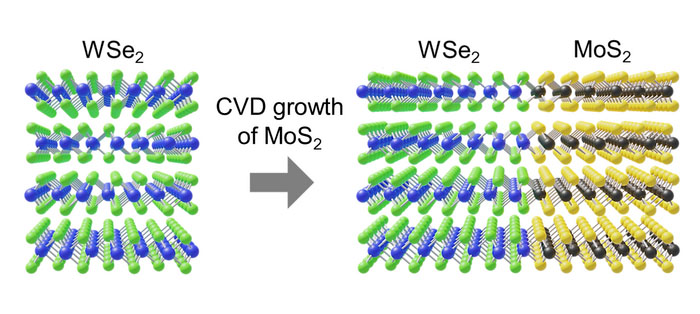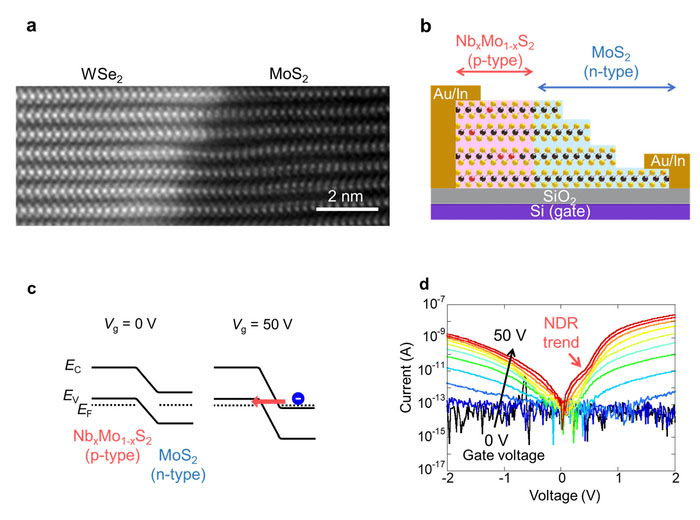| Apr 22, 2023 |
From sheets to stacks, new nanostructures promise leap for advanced electronics
(Nanowerk News) Researchers at Tokyo Metropolitan University have successfully developed multi-layered nanostructures of transition metal dichalcogenides (TMDCs) that form in-plane junctions. By growing multi-layered molybdenum disulfide structures from the edge of niobium-doped molybdenum disulfide shards, the scientists created a robust, bonded, planar heterostructure.
|
|
They demonstrated that these structures could be used to create new tunnel field-effect transistors (TFETs), which are components in integrated circuits with ultra-low power consumption.
|
|
The research has been published in ACS Nano ("Multilayer In-Plane Heterostructures Based on Transition Metal Dichalcogenides for Advanced Electronics").
|
 |
| Chemical vapor deposition can be used to grow a multi-layered TMDC structure out of a different TMDC. (Image: Tokyo Metropolitan University)
|
|
Field-effect transistors (FETs) are essential components in nearly all digital circuits, controlling the flow of current depending on the applied voltage. Although metal oxide semiconductor FETs (MOSFETs) currently dominate the market, researchers are searching for next-generation materials to create increasingly efficient and compact devices that use less power. Tunneling FETs (TFETs) represent a promising alternative, relying on quantum tunneling, which allows electrons to pass through seemingly impassable barriers due to quantum mechanical effects. However, developing a scalable implementation of this technology remains a challenge.
|
|
Under the guidance of Associate Professor Yasumitsu Miyata, the team at Tokyo Metropolitan University focused on creating nanostructures from transition metal dichalcogenides (TMDCs), which are mixtures of transition metals and group 16 elements. TMDCs are ideal candidates for TFETs due to their unique properties. The researchers have achieved remarkable success in stitching together single-atom-thick layers of crystalline TMDC sheets, and they have now shifted their focus to multi-layered TMDC structures.
|
|
Employing chemical vapor deposition (CVD), the team demonstrated that they could grow a different TMDC from the edge of stacked crystalline planes mounted on a substrate, creating an in-plane junction with multiple layers. Previous work on TMDC junctions primarily involved monolayers stacked atop one another, as achieving high hole and electron concentrations required for TFETs had proven elusive with in-plane junctions.
|
 |
| (a) Scanning transmission electron microscopy picture of a multi-layered junction between tungsten diselenide and molybdenum disulfide. (b) Schematic of the circuit used to characterize the multi-layered p-n junction between niobium doped and undoped molybdenum disulfide. (c) Schematic of energy levels of conduction band minimum (Ec) and valence band maximum (Ev) across the junction. The Fermi level (EF) indicates the level to which electrons fill the energy levels at zero temperature. When a gate voltage is applied, electrons in the conductance band can tunnel across the interface. (d) Current-voltage curves as a function of gate voltage. The NDR trend can be clearly seen at higher gate voltages. (Image: Tokyo Metropolitan University)
|
|
After validating their technique using molybdenum disulfide grown from tungsten diselenide, the researchers turned to niobium-doped molybdenum disulfide, a p-type semiconductor. By growing out multi-layered structures of undoped molybdenum disulfide, an n-type semiconductor, the team created a thick p-n junction between TMDCs with exceptionally high carrier concentration. They also discovered that the junction exhibited a negative differential resistance (NDR) trend, a key feature of tunneling and a critical first step toward incorporating these nanomaterials into TFETs.
|
|
Notably, the team's method is scalable over large areas, making it suitable for circuit fabrication. This groundbreaking development holds great promise for the future of modern electronics, and it is anticipated that these innovative materials will find their way into various applications.
|


